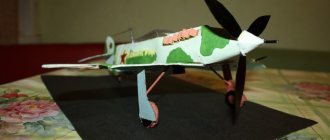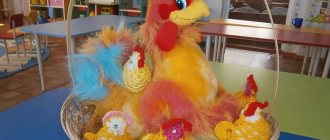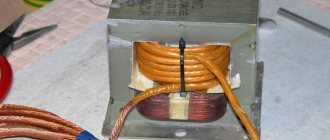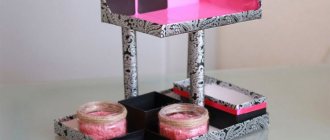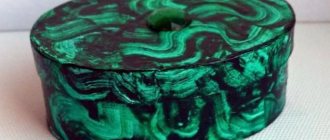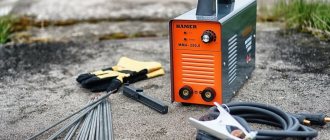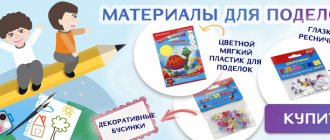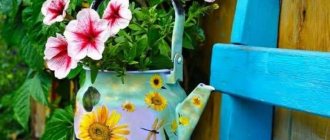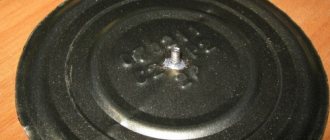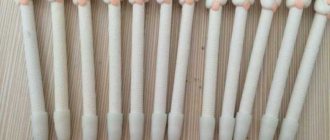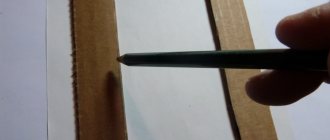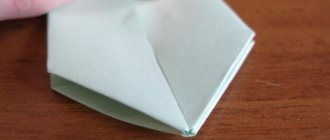How and from what to make a brownie figurine?
There are many styles and methods of making figurines. A fabulous guest can be accommodated in any interior style. Today we will share the main methods and techniques for creating brownies.
Decorative dolls are made from different materials. Threads, colored cardboard, burlap, tin cans, natural and other available materials are used. Try making them yourself using our tips, and you will see that this is a very exciting activity.
Weaving from newspaper tubes
Nowadays, such material is very often used to make various kinds of souvenirs, interior items, baskets, boxes, etc. Bast shoes made from newspaper tubes look very attractive and at the same time naturalistic. In any case, they look no worse than those made from bast. In some cases, not only souvenir bast shoes are made using this technology. Weaving various kinds of products from newspaper tubes is quite simple and quick. Even from this seemingly not very durable material, if desired, you can also make bast shoes intended for wear. Replacing slippers with such a product will be relatively simple.
Making a brownie from threads
We offer a step-by-step guide to making a brownie craft from threads for a technology lesson in 2nd grade. School-age children will be happy to spend their time creating a cheerful fairy-tale character. They will cope with their work without much difficulty. At home, you will be interested in working together with your child.
Minimum materials required:
- pre-prepared templates;
- a set of colored cardboard and paper;
- white cardboard;
- any yarn;
- glue;
- scissors.
Difficulties may arise when creating a pompom from yarn. You'll have to try a lot here. If your child is involved in the process and has no experience, your help will be needed.
Take colored paper and draw on it several patterns for eyes, ears, tongue, arms and legs. If colored paper is not available, use cardstock. Make the tongue a little rounded to make the doll seem cheerful.
Now we will create a pompom. On cardboard, draw two round disks with a radius of 5 cm. Inside them are circles with a radius of 2 cm. Cut out so that you get a pair of “wheels”. Place them together and wrap a thick layer of yarn around them.
Carefully cut the threads between the rings along the outer perimeter. Make sure that the rings do not move so that the yarn does not fall apart. Tie the middle tightly with yarn and tie with two knots. Now get rid of the cardboard and fluff the pompom without cutting off the tying knots.
The resulting pompom will serve as the body of the brownie. Glue the prepared parts onto it using PVC glue. We got a brownie boy. For a girl, just stick a cute bow or flower on top.
We make traditional bast shoes from birch bark with our own hands
Of course, traditional birch bark bast shoes will not escape our gaze either. This master class will allow you to better understand how they were made in Rus', because bast shoes were the only available foot protection for a long time.
To make it, you will need birch bark, 1 cm wide, and a clamping device (preferably wire).
Progress of work with a detailed description.
- Take the wire, make a clamp by folding it in a cross. On this basis, weave a rug from three strips of birch bark.
- To create the nose of the product, first intertwine the first and second ribbons, then the third and second.
- Weave all intersecting sections.
- Make 2 more corners.
- Decide which side will be up and which side will be down based on which leg you are weaving on.
- For example, the right bast shoe. Using tapes 1 and 2, make the first corner on the side with two sections.
- Then on the opposite side you also weave a corner (they should be symmetrical).
- Next, intertwine all the intersecting stripes.
- Make an edge using the first and second tape to make it stronger, pass them under several sections.
- If any of the ribbons become very short, weave in an additional one, thereby lengthening it.
- We insert the first ribbon into the weave, then tighten the inner one so that it turns out to be outside.
- We make another corner using 1 and 2 stripes.
- Weave an additional ribbon on the opposite side and continue the edge.
- Make a second corner and finish the heel.
- Using the same principle, make a bast shoe for the second leg.
This type of work is far from suitable for novice needlewomen, as it requires certain experience and skills in the way of weaving parts.
In Rus', almost everyone knew how to weave bast shoes, but now this requires training. Next, let's look at a simpler method of making, albeit souvenir products.
Brownie made of burlap and filler
Toys made diligently and with love always attract attention and look beautiful. Handmade crafts are very common. For example, a brownie made of burlap. Let's consider two options for its manufacture.
The first option is with filler.
Prepare the following materials:
- burlap;
- scissors, threads and needles;
- any strong rope;
- filler;
- plastic eyes;
- decorative elements (cones, artificial leaves, flowers, etc.);
- corrugated cardboard;
- plastic cover;
- heat gun.
- Cut a rectangular shape from the burlap, approximately 25 cm by 30 cm. Fold it in half. Pull 15 - 20 threads from one part of it.
- Carefully fold the threads together and make a beard and nose out of them. First tie them in the middle. Then, to form a spout, tie them with strong rope (for example, jute).
- Fluff up your beard.
- Next, take a piece of burlap and sew it along the sides. The bottom corners should remain rounded.
- Turn the resulting bag right side out. Just below the top fringed edge, sew with regular stitches.
- Now fill the toy with any filling, sew and tighten it on top.
- Draw four leg shapes on cardboard, cut them out and trace around the edges with a red marker. From burlap, cut out shapes for each leg that are slightly larger than their dimensions.
- Glue the fabric to the cardboard parts with a heat gun.
- Glue each piece together on the inside. Apply jute around their perimeter. Decorate the legs with jute bows and glue them to the body.
- Using a heat gun, glue plastic eyes on top of the body, and a beard made of threads between them.
- The hat is also made from jute. For its crown, use a transparent plastic cover.
- Make a braid out of jute and twist it in a circle. Then glue it to the center of the lid. Continue pasting the lid until you reach the end of it.
- At the end of the cap, the pigtail is glued so that the brim of the cap begins to form. Carefully glue the end of the rope with hot glue.
- Sew the hat to the body, and on its sides - a few pine cones and green leaves.
Stage No. 10
Hair creation process. A ball of yarn is wound around any medium-sized book that comes along. After which this skein is carefully laid out on a sheet of A4 paper. A line is sewn right in the middle on a sewing machine. For reliability, it is advisable to sew another 2-3 lines.
After which one of the halves of the yarn is visually divided into two, where another line is sewn. It is secured a couple of times with additional stitches.
The two edges of the yarn are trimmed. Then you need to cut the yarn exactly as shown in the picture to get three strips of future hair. Strips of short pile yarn are divided into two parts.
One short strand of hair is sewn to the back of the head. The next three strands are sewn at a distance of 3 mm from each other. The longest strand is sewn to the crown in a spiral. The process begins with bangs.
At the end of the brownie, you can comb it and cut off all the extra protruding hairs.
It is advisable to give the wonderful brownie a spoon, a chest with a dowry or a bag.
To fulfill their desires, people often resorted to magic, spells and magical rituals. To prevent the brownie from getting angry, scattering or hiding things, they fed him and left sweet milk on a saucer. A homemade brownie made from burlap served as a reliable talisman for the family hearth.
Brownie made from burlap and tin cans
This method uses a large coffee tin as the inner base. From other materials, take:
- burlap;
- heat gun;
- button;
- plastic eyes;
- scissors, threads and needles;
- decorative elements (broom, ladybugs, artificial leaves, etc.);
- plastic cover.
- According to the previous technique, make a mustache and nose and form a hat. Set them aside for now.
- Place a coffee can on a piece of burlap. There should be enough material to completely wrap the base. All excess is cut off.
- Wrap the jar completely and make a strong knot at the top.
- Additionally, glue this connection so that the knot does not come undone.
- Take a heat gun and use it to glue plastic eyes onto the body.
- Tie the button-nose with jute material and also glue it just below eye level.
- Add a mustache.
- Cut out the legs from colored cardboard and glue them under the bottom.
- Glue or sew the pre-prepared hat on top.
- As in the previous version, you can use various decorative elements. Glue a small straw broom and a bag to the side of the brownie.
Preparation of materials and tools
Before weaving bast shoes, you need to decide on the material. It should be chosen depending on the purpose of the product. In the old days, bast shoes were woven from bast, birch bark and straw. Durable products are made from linden and hemp rope, but willow ropes are destroyed after only 5-10 wears.
Any strip of bark is called bast, but it is most convenient to work with linden. Raw materials are harvested in the spring from young trees. The preparation of the bark proceeds as follows:
- The trunk is cut low.
- The bark is ripped open, after which the core is pulled out.
- The material is rolled into a ring.
- Strips are cut into 10 mm wide strips.
- The raw materials are dried in a well-ventilated place without direct sunlight.
Before you start weaving bast shoes, you need to soak the material in water for a day, steam it and completely clean the strips of bark residues.
Other materials for weaving bast shoes - newspaper tubes, twine, burlap - are also suitable for making decorative items. When creating these shoes from paper tubes, to prepare them you will need:
- a stack of newspapers;
- scissors;
- PVA glue;
- pencil;
- knitting needles 2-3 mm long;
- water in container.
Products made from birch bark look interesting. Before weaving bast shoes from birch bark, you need to properly prepare the raw materials. This should be done in the spring, when the leaves bloom. The material is collected in a spiral; it is better to choose trees no more than 15 cm in diameter. You will need to cut the bark with a ribbon, collect the balls with the white side out, separating the inner layer. Before weaving the strips, it is recommended to soak them in water for a day, and then remove the excess bark, making them 10 mm wide.
Before starting work, you need to prepare the tools for weaving bast shoes. You will need a knife, a picker, a grinder, and a block for the future product. It can be made from foam or wood.
As a model, you should use smooth shoes without locks and additional decorative elements.
For bast shoes from newspapers
Preparation of raw materials for weaving from birch bark
Treated birch bark for weaving bast shoes
Materials for weaving from bast
Beautiful craft made from natural materials
There are many original ideas for creating amulets dolls. For example, with your own hands you can create a cheerful brownie Kuzya from natural materials. Prepare everything you need:
- a cookie box for the base;
- colored fabric for the background;
- birch bark;
- tinder fungus;
- small sunflower flower;
- dried aspen and lily of the valley leaves;
- Jerusalem artichoke flower;
- leaf-shaped sequins;
- colored gouache and brushes;
- glue;
- needle and thread;
- scissors and stapler.
- Staple the colored fabric to the bottom of the box. Sew along the length so that it does not sag when the box is placed on its side.
- Take birch bark and cut out arms and legs from it. Additionally, make bast shoes from white birch bark.
- Make a hole in the left handle and insert Jerusalem artichoke into it.
- Attach bast shoes to each leg so that they can move.
- Cut out the facial elements from paper: mouth, nose and eyes. Attach them inside the sunflower flower.
- Sew the arms and legs to the fabric base. Then attach the tinder body. Sew the head on top.
- Our fairy-tale hero must be dressed in a shirt. To do this, paint over the body with red gouache. Make the trouser legs blue and the oxen yellow. The shirt can be decorated with large white polka dots.
- Cover the edges of the hut with logs made of colored paper.
- On the front side, use dry leaves and decorative sequins for decoration.
- Cover the reverse side with paper of any color to hide the seams.
Excursion into history
Lapti first appeared in Rus'. These shoes were made from bast and birch bark, and later twine began to be used.
Bast shoes were light and comfortable shoes, but with a low service life. On average, per year a peasant trampled from 50 to 60 pairs of bast shoes.
Families at that time were quite large, so all generations, from small children to old grandmothers, began weaving shoes. If a person did not have weaving skills , then they said about him “he can’t knit,” that is, he is not able to do even the most basic things. Although in the modern world this saying has undergone several changes and is used to refer to very drunk people.
The preparation of material for making shoes began in early spring. The bark was peeled from young linden trees, after which it was soaked and a thin layer was scraped off, exposing the bast. The weaving of bast bast shoes differed in different settlements, so by studying the features of a person’s shoes, it was possible to roughly understand what area he came from. The foot prints were attached in the manner of Greek sandals.
Today these shoes are a thing of the distant past, but they are sometimes remembered when making Slavic-type dolls.
Brownie Kuzya
We all know this funny cartoon character, it’s time to make a Kuzya brownie craft with your own hands so that it becomes an ideal amulet for your home.
- To do this, you will need white calico, dark-colored textiles and bright ones for sewing a brownie shirt.
- Cotton wool is suitable for filling.
- Also prepare beige or white wool threads, a pencil, acrylic paints with a brush, you can’t do without scissors and a sewing machine (although you can sew by hand).
Instructions for weaving different models
Craftsmen who make these shoes use birch bark, bast or more modern raw materials to create them. For example, very beautiful bast shoes are made from newspaper tubes, knitted yarn, and jute twine.
From newspaper tubes
This raw material is very common as a material for weaving bast shoes. The finished product looks beautiful and resembles shoes made of natural material.
For weaving you will need:
Before weaving bast shoes, you need to prepare the material. This process is not particularly difficult; even a beginner can easily cope with this task:
To prepare the segments, it is recommended to cut a whole stack of newspaper sheets at once.
Before you start weaving, the tubes need to be slightly moistened without flattening. How to make bast shoes step by step can be found in the following instructions:
This weaving pattern is one of the simplest. Thanks to her, even a beginner can figure out how to weave bast shoes.
From knitted yarn
Such products look beautiful and are very easy to use, and even a novice craftswoman can make them. To work you will need:
Before weaving knitted bast shoes with your own hands, you need to prepare the yarn. To do this, cut strips about a centimeter wide from the canvas. After which they need to be sewn into one continuous thread.
The knitted fabric is soft, stretches well and takes the desired shape. That is why with its use, weaving bast shoes is easy and pleasant.
When the yarn is prepared, you can start weaving:
Next, all that remains is to knit a chain for the laces, which are secured to the heel.
Knitted from jute twine
Before making bast shoes, you need to prepare the materials. To weave bast shoes from twine you will need:
Beads, glass beads, and artificial flowers are useful for decoration. The instructions show how to make decorative slippers. Using a similar pattern, you can knit a full-size pair of shoes.
The second bast shoe should be knitted using a similar pattern. They are fastened in pairs. Woven products can be given as a souvenir or kept for yourself. If desired, the bast shoes are further decorated.
Manufacturing technique
The first thing you need to start with is drawing and cutting out models to create patterns. These are two parts for the future shirt, four from which you will sew the brownie’s arms, four parts for the panties, one for the nose, five for the head, two parts for sewing the brownie’s body and, finally, four for making the legs.
Once you have cut out the pieces from the paper, trace them onto the back of the folded fabric. Cut out as many pieces as you need for the job. After sewing the elements along their contours, turn the resulting pieces inside out.
Stuff the body parts of the future brownie with cotton wool, especially filling the head with it so that it is even. Gather the pieces and sew them together by hand. The circle that is cut out for the nose is gathered around the edge, filled with a small piece of cotton wool and pulled together, and then sewn to the head.
Master class: making a Domovoy figurine | Magazine of the Fair of Masters
In the mythology of the Slavic peoples, the existence of a spirit guarding the house and household members - the Domovoi - is often mentioned. He was usually represented as short in stature, with long, shaggy hair. Some imagined Domovoy as a young man, and some as a wise old man, protecting the peace and well-being of the residents of the house. The Domovoy was supposed to be treated with special respect: upon entering the house, they bowed to him, and at night treats and coins were left on the table.
Today I decided to make a Domovoy figurine and show you the whole process.
So let's begin!
To begin with, let’s take directly what we will make the figurine from:
This is a small linden log. The set of required tools is quite simple: a jamb knife, a semicircular chisel, a corner chisel and a pencil.
First, the workpiece is processed with a knife to get rid of the reddish-colored wood layer located under the bark:
We give the upper part of the log a more rounded shape to create the head of our future figure and mark the location of the arms and beard:
Let's give the head a more regular shape:
We cut through the nose, eyebrows and beard with mustache:
We finally form the nose and cut out the eyes in more detail. The brownie turned out to be quite harsh, but how could it be otherwise? Only strictness maintains order in the house:
We begin to give the correct shape to the body. Cutting the hands:
And also at the back we cut the border of the hair, belt and bottom of the shirt:
More accurately we cut through the cane and belly in the figure’s right hand:
We begin to shape our Brownie's shoes - bast shoes:
We finally finish giving the figure a shape:
To make the shapes smoother, we process our fishur with sandpaper:
Now let's move on to finer carvings. We use a corner chisel to depict hair and beard:
We cut through the spikelets, as well as the fingers:
We finish the carving with a pattern cut on the clothing:
Now let's move on to the most colorful stage of the work. Using water-based stains of different shades, we paint the figurine:
This is roughly how it all works out. In my opinion, it looks much more interesting than painting it with one color:
After the stain has dried, take sandpaper again and highlight the convex areas of the figure:
Now we apply the finishing coat. For this I use this wax. Apply it with a toothbrush.
After the wax has dried, lightly polish the figurine with a cloth to obtain a slight shine:
I made a shelf especially for the figurine. A box with coins represents material wealth in the family, grains in a bowl represent bread, and a candle represents light and warmth in the house.
Thank you all for your attention! Good luck and creative success to everyone!
Brownie costume and face
Draw eyes and a mouth on Kuzi's head, and then paint them with acrylic paints.
- Cut out the parts for the shirt from bright fabric, and from dark fabric for the pants.
- You can sew a small button onto your shirt.
- Sew them and put the pants on the toy, hemming the fabric on the stomach and legs along the bottom edge.
- Then dress the brownie in a shirt.
- The head is sewn on, the seam should be hidden so that the finished product looks neater.
Product requirements
To appease the owner of the house, you should make his image according to traditional rules:
- choose the material carefully;
- think about who the amulet is intended for;
- do it carefully, without haste;
- think about good things while working;
- observe shapes and proportions.
All elements from which the amulet will be made must be natural: both the outer part and the filler. In order for the guard to turn out to be of high quality, he is endowed with positive energy; in the process of creating a craft, they think only about good things.
If the amulet is given as a gift, they think about who it is intended for, imagine an image in front of them and remember various little things, character details. The shape of the amulet is made in the human image, observing the proportions of the body, arms, legs and head.
At home, brownies are made using different technologies and from different materials. They differ in their purpose.
For a master class on making a talisman you will need:
- thin burlap;
- filler (cotton wool, padding polyester or sawdust);
- thick thread or twine;
- button eyes;
- flax tow;
- PVA glue;
- "hot" gun;
- decorations (dry berries, spikelets, grains, etc.).
Sew a bag from a piece of material (15x25 cm), first 3 sides, then turn it inside out and straighten the corners
For the power of the amulet, it does not matter how you sew: by machine or by hand.
The bag is filled with prepared filler. Small holes are made on the side for the hands (with a pencil or pen) so that the size matches the selected scale.
Hands are made from braided twine, a piece of fabric or burlap. They are threaded through the holes and pulled out from both sides, making them equal in length.
They step back from the top edge of the bag and tighten it with thread or twine, which serves as the crown. There, “hair”, which is made from thread or straw, is attached with PVA glue. The hair is cut and parted in the middle, as usual for a brownie.
The legs are made from rolled twine, which is cut to the required length and inserted into improvised bast shoes made from corn leaves. Craftsmen weave “boots” from thin twigs or wheat ears.
A hat is sewn from any fabric and placed on the head. If you want to have a mustachioed Kuzya, your mustache is made from tow.
Decorative eyes are attached with a glue gun. The mouth is made from half a lentil grain, and a bean is used as a nose. The brownie made from burlap is ready.
To give meaning to the amulet, a bag is made for it, which is filled with coins or grains, sawdust or grass, as desired and for the purpose of use.
Options for making a talisman
There is more than one option for creating modern amulets.
Option using tights
To make a toy, simply use nylon from old beige tights, padding polyester for stuffing and three rolls of tape for the base.
- Due to the beige nylon and soft padding polyester, it is easy to work out facial features, give them individuality and similarity to human ones.
- To make the legs, use disposable teaspoons and cover them with burlap. The feet become like real ones.
- Soft wire is used to create hands. It is given the desired shape, wrapped with cotton wool on top and covered with the selected fabric or burlap.
- They sew beautiful clothes and decorate them with decorative elements: beads, ribbons, etc.
Brownie hairstyle
Take the yarn and wind it onto a piece of cardboard. Carefully remove the wound threads and place them on the paper. Sew straight down the center of the paper.
- Select one half of the stitched yarn and sew two more stitches on it.
- Cut into several pieces.
- Sew the hair to the brownie's head (shorter at the bottom, longer at the top, placing it in a circle).
- Comb and distribute to create a parting.
- All that remains is to make twine from wool and weave bast shoes from it.
Another option for knitting mini bast shoes
The length of such knitted shoes is 12 cm. They are knitted in single crochets, tightly, without unnecessary holes. Step-by-step knitting plan:
- Make a chain of 10 chain stitches.
- When tying in a circle, at turns, knit 5 stitches from one loop.
- Knit 2 more round rows. On turns, knit 2 sc from each of the previous 5 stitches.
- Knit in the round, crocheting the far half of the loop.
- Knit row 1 using both halves.
- Turn the product and continue knitting the toe according to the following pattern: 1 chain stitch, 6 sc. In the center, knit 2 times, 2 stitches together, 7 sc.
- Turn over: 1 chain stitch, single crochet to the center of the toe, 2 times 2 sc together.
- Rotate and duplicate the previous pattern. Tie a knot, cut the thread and sew the sock along the seam.
How to knit doll shoes was discussed above, and by watching the next video, you will learn how to knit large size shoes.
Brownie made of threads
If you are wondering how else you can make a brownie craft, in the presented photo of crafts on the theme of brownies, you can see a brownie craft made from threads.
You will need colored cardboard, colored yarn, some glue, scissors and paper.
- Draw on cardboard and cut out eyes, legs, arms and a circle for the body.
- Then glue the yarn onto the cardboard circle, placing the threads from the center.
- It remains to fasten the button in the center as a nose, and closer to the edges of the legs and arms.
- The basis of the workpiece will be a sheet of paper, transfer the brownie onto it.
- You can cut out a hat from cardboard and decorate the craft as your imagination dictates.
- This technique is quite simple, if you are looking for an idea for a brownie craft for grade 2 and younger, your child can easily make such a product.
Unusual souvenir
Lapti can be made not only in real size, but also in miniature ones as a gift to loved ones. For our work, we will need satin ribbons, the bast shoes from which will look very cute.
Necessary materials for work:
- cardboard;
- silk fabric in the color of the ribbons;
- satin ribbons (width - 1.2 cm, length - 3.5 m);
- glue;
- scissors;
- needle;
- threads in the color of the ribbon.
First of all, you need to cut out four symmetrical ovals from cardboard paper. Next, cut the ribbons into lengths slightly larger than the blanks. Then glue them by the edges so that there are no gaps on the back side between the strips. In the same way, cut out the transverse ribbons, before fastening, passing them through the already glued ones so that squares come out. Cut off the nose of the bast shoe from two blanks and glue one in the same way as the sole. Cut a piece of silk fabric slightly larger than the sole. Do the same for the nose.
Related article: What do you need to know before gluing photo wallpaper?
Glue silk fabric to the third blank. Repeat this with the remaining piece for the spout. Collect our bast shoes. Now all that remains is to decorate the product with threads. To do this, take one satin ribbon and pass the thread through it in the center with a basting stitch. Pull the ribbon so it looks wavy. Glue this part along the contour of the bast shoe. If you wish, you can make a bow for decoration. Satin ribbon bast shoes are ready!
Brownie molded from plasticine
An educational and exciting activity for a child.
- Plastic plate,
- Board and plasticine.
Take pink plasticine, parts of the brownie's body will be molded from it.
- Now you can move on to the boots - they are made of black plasticine.
- Move on to the face - make the nose, as well as the eyes and beard.
- The plate will serve to draw any background on it, and then place the brownie on it.
A beautiful composition is ready!
Let's plunge into the past
Weaving is one of the most ancient types of needlework. In the old days, many household items were woven by hand - baskets, fences, furniture, shoes, toys. This type of needlework had a sacred meaning; it was believed that everything created with love for someone was a talisman for him. Often mothers made wicker toys for their children or hung up a dream catcher, in whose threads bad dreams were entangled.
In Rus', the most common wicker items were baskets and bast shoes. Both of these items were actively used in everyday life. Bast shoes are light, pleasant to wear (of course, for feet protected by onuchas or foot wraps), but short-lived. On average, one member of a peasant family trampled 50-60 pairs of bast bast shoes per year. And families were very large back then, so all members of the family, from young to old, were engaged in making shoes. About those who did not know how to weave these shoes, they said “bast does not knit”; in the modern world, the proverb is more often applied to a drunk person. Then this meant that he could not perform the most basic actions.
Shoes were woven from plant material. And the bast shoes themselves bore the name of the tree from which they were made: birch bark, oak, broom. Their names also came from the number of strips of material involved in weaving - fives, sixes, sevens, etc.
The preparation of material for weaving was carried out in early spring. With the beginning of sap flow, thin strips of bast - bark - were peeled off from young linden trees. A lot of it was required. Before starting work, the bark was soaked and the top layer was scraped off, exposing the bast. Despite the fact that peasants harvested a lot of bast, Russian forests did not become extinct. Our ancestors deified nature and treated it with care. They knew how to collect tree bark without destroying the tree.
Among different peoples, wicker shoes differed in appearance. Based on the style of the bast shoe, one could easily guess where its owner was from. The bast shoes were attached in the manner of Greek sandals. A rope was tied to them, which encircled the leg over foot wraps.
The five-piece bast shoes were woven according to a similar pattern, which every weaver knew by heart.
In modern Russia you will not meet a person who does not know what a bast shoe is, but only lovers of folklore can wear these shoes. But it has found wide application among needlewomen who weave bast shoes as souvenirs and decoration.
Brownie from a jar
There are probably empty coffee or tea cans in your house. Don't throw them away, they make great decorations for your kitchen!
In addition, a talisman in the form of a brownie, made with your own hands, will bring you prosperity and well-being.
- To start, you will need a tin can.
- Then take flax hemp, which will need to be wrapped around this jar.
- Treat the edges of the hemp with a heat gun so that the product is durable and does not unravel.
- Now take the wool threads and make a tassel out of them, the ends should be long.
- Tie the top of the hand to create a nose.
- The edges are the beard of a brownie, they need to be fluffed up.
- Attach the resulting element to the decorated jar.
- Now add the eyes by gluing the finished plastic hell nose.
- Now take the lid and wrap it with twine made from colored yarn.
- This will give you a brownie hat.
You can decorate it with an artificial flower on the side. This product can be used as a box.
Weaving a birch bark basket
So, we weave a birch bark basket. What is the proportionality here between the pester and the basket with a bast width of 3.5 cm?
Pester 3x4x8 - basket 3x3x3. Pester 3x5x9 - basket 3x4x3.5. Pester 3x6x10 - basket 3x4x3.5.
Setting up the bottom of the basket, braiding the corners and walls - everything is like a pester. A special feature is the braided handle. Some masters cut into handles, but I believe that this is violence. Everything in a wicker product must be woven together.
How it's done? Having built up the walls to a height of 3.5 times the width of the bast, we begin to make a hoop. For the hoop, it is best to use rowan, bird cherry, willow or birch. We split a shoot 10-15 mm thick in half, cut off the core and, cutting it to the required length (2 widths + 2 base lengths), make a hoop.
Don't forget about the overlap to secure the hoop. Having passed the running ends of the tape through the hoop, we install it at a height of 3.5 times the width of the bast (Fig. 9), like a binding, and braid the edge according to the pester pattern. But first we sew a handle of 3-4 ribbons to the hoop. The length of the handle should be equal to 6 diagonals of a square with a side the width of the bast.
| Rice. 9. Braiding the basket handle. | Rice. 10. Completion of weaving the handle of the basket. |
For density, it is better to sew the handle with large stitches. We fill the 1st and 2nd basts, as shown in Fig. 9, on the outside, and the 3rd and 4th basts on the inside of the basket. And we begin to braid the stitched handle according to the pattern: 1st bast under the handle, 3rd bast over the handle, 4th bast over the 3rd bast, 2nd bast under the handle and 1st bast. And then - “each bast is in a line.” The completion of weaving the handle is shown in Fig. 10. Having cut off the protruding ends along the diagonals, we continue braiding the outer layer of the basket according to the pester pattern.
Burlap brownie
This craft is perfect as a children's toy. You will need a square shaped piece of burlap.
- Sew a circle on it, using the seam forward with a needle, and place a piece of cotton wool in the center.
- Then pull the thread and hide the edges inside.
- Now you need to make the arms, legs and shoes.
- Twine made of yarn is perfect for this, from which these parts will be woven.
- They are attached with glue or sewn with thread.
The finishing touches are decorating the toy. It could be a headdress, a flower and much more.
These interesting and beautiful products in the form of a brownie can be made from a wide variety of materials. And most importantly, this is a very interesting and useful process that will develop fine motor skills and imagination of your child. There are many techniques of varying complexity, everyone can find something for themselves.
The finished product will serve as a decoration in the room, a talisman, as well as a toy or box if it was made from a can.
Source
Tools and improvised means
Before making a bast shoe, you should select the most suitable material and prepare the necessary tools:
- Knife.
- Kochedyk is a tool with a metal rod and a wooden handle, a flat horizontal end, somewhat reminiscent of a screwdriver, but curved in the horizontal plane. Designed to lift the loops of the woven part and insert the free bast end into them.
- A block (if the bast shoes are versatile, then there are two blocks - right and left), made of wood or polystyrene foam.
You can make decorative models or make bast shoes for a child’s party using available materials. Rolled and glued pages of old newspapers and magazines, plain paper, sheets of old notebooks, and posters are perfect for this.
What is the meaning of the word “bast” in sayings?
Many proverbs and sayings with the word “bast” have reached us. Only some of them relate directly to bast products and the process of their manufacture. The rest are used by folk wisdom as illustrative examples for analogy, comparison or hyperbole. Let's look at some:
- The bast does not knit - this is what they say now about a person who is incapable of basic independent actions, or about a lazy person who avoids work. Why bast? What it is? Allegory? No. Knitting bast (tying into bundles) is a simple operation that even a child can do. They tied bast for weaving ropes, making brushes, washcloths, and preparing bundles for future work.
- Don't be fooled - now the proverb means a person who cannot be deceived. He is not simple, he has knowledge and experience. Previously, a completely bankrupt peasant could wear clothes sewn with coarse bast fibers, which were only suitable for mending fishing nets. The belt could also be twisted from bast. But if he had friends or relatives, this could not last long. In the end, the man with his hands and head on his shoulders acquired new property. Those who did not want to work, drank away the clothes given out of mercy, and did not enjoy respect in society. They said about such people: they are sewn with bast, they are girded with bast.
- Not every bast in line is a saying of the Lapotniks. When weaving bast shoes, lines were distinguished, that is, rows. They were selected based on color and quality. Some were no good. This is what they said about those who are not suitable for some task, who stand out from the general mass due to some kind of shortcoming.
Typical types of bast shoes and manufacturing methods
Lapot m. Lapotok; bast shoes, bast shoes m. postsoli south. zap. (German Basteln), short wicker footwear, ankle-length, made from bast (lychniki), mochala (mochalyzhniki, ploshe), less often from the bark of willow, willow (verzki, ivnyaki), tala (shelyuzhnik), elm (elm) , birch (birch bark), oak (oak), from thin roots (korenniki), from young oak chips (dubachi, chrng.), from hemp combs, broken old ropes (kurpa, krutsy, chuna, sheptuny), from horse manes and tails (hairworts), and finally from straw (strawworts, chickens).
The bast shoe is woven in 5-12 rows, bunches, on a block, with a kochedyk, a cat (an iron hook, a pile), and consists of a wattle (sole), a head, heads (front), an earpiece, a collar (borders on the sides) and a heel; but the bast shoes are bad, simply woven, without a collar, and fragile; The collar or border meets at the ends of the heel, and when tied together, forms an obornik, a kind of loop into which the frill is threaded. The transverse basts that are bent on the ear guard are called kurts; there are usually ten kurts in the fence. Sometimes they pick up the bast shoes and pass along the fence with bast or tow; and the painted bast shoes are decorated with a patterned undercut. (Dahl's Dictionary)
The strongest and softest in this series were considered to be bast bast shoes, made from linden bast, and the worst were willow carpets and bast shoes, which were made from bast. Often bast shoes were named according to the number of bast strips used in weaving: five, six, seven. At seven o'clock they usually wove winter bast shoes. For strength, warmth and beauty, the bast shoes were woven a second time using hemp ropes. For the same purpose, a leather outsole was sometimes sewn on. For a festive occasion, written elm bast shoes made of thin bast with a black woolen braid, which was fastened to the legs, were intended. For autumn-spring chores in the yard, simple high wicker feet without any braid were considered more convenient. Bast shoes made from strips of fabric were called bast shoes. Bast shoes were also made from hemp rope - krutsy, and even from horsehair - hair. These shoes were worn at home or worn in hot weather.
Great Russian bast shoes had oblique weaving, while in the western regions they used straight weaving, or “straight lattice”. In Ukraine and Belarus, bast shoes began to be woven from the toe, while Russian peasants did the work from the back. Moscow bast shoes, woven from bast, are characterized by high sides and rounded toes. In the North, they usually made bast shoes from birch bark with triangular toes and relatively low sides. Mordovian bast shoes, also common in the Nizhny Novgorod and Penza provinces, were woven from elm bast.
The concept and meaning of a talisman for the home
Not every guest pays a visit with bright intentions. This applies even to close relatives.
And the main meaning of brownie amulets is defense against unnecessary guests and dark intentions. This is a special talisman. And if it is selected and prepared correctly, it blocks negative energy from entering the house. A house amulet will make a guest who comes with dark thoughts feel severe discomfort. And he will not be able to realize his plan.
And when such a talisman appears in the house, you need to study all the visiting guests. If someone starts to behave strangely, it means that the amulet is working on him.
The house amulet performs not only a defensive function. It fills the house with bright energy, creates harmony in family relationships, and calms.
Staying in an apartment under his influence is always very pleasant. Fatigue is quickly eliminated and strength is restored.
If the house amulet began to crack and darken, it worked hard and exhausted its potential. It needs to be replaced. Cracks can even form on metal products. Especially if the attacks of negative energy were very powerful. A talisman that is devastated energetically should be immediately removed from the house. Its replacement can be purchased or created on your own. The second option is more optimal. Homemade products are characterized by great potential. You can also give them as a gift to someone.
Brownie doll - a talisman or just a piece of furniture
As mentioned above, amulets are now often chosen by people who are completely ignorant in the world of magic. They are given amulets as gifts or they themselves buy beautiful dolls at fairs. A significant story that happened several years ago and perfectly demonstrates how an ordinary household talisman can determine human destiny.
Girls strive to decorate the interior of their home in every possible way with the help of unusual things. This happened that time too - the girl simply bought a stylish brownie doll from the salon of hand-made things that are popular nowadays. Not fitting into the design, the doll went to the mezzanine, where it collected dust for several long years. During this time, a number of negative changes occurred: my husband left, I was laid off from my job, and I had two surgeries. It would seem that misfortunes come from everywhere and the black streak will never end. Only a few days later the source of the problems was found - the brownie doll, having forgotten on the mezzanine, began to take revenge on the owner. Having pulled it out, performed a sacred ritual, and placed it in the required place, she began to act completely differently. The brownie helped resolve the problems in just a few days. Therefore, do not underestimate this little helper with great power.
Outfit for Kuzi
Let's move on to sewing the outfit. Let's sew some pants for the baby. Take a piece of any thick stretchy fabric. Maybe a piece of an old sweater. We cut out the panties by taking measurements from the workpiece. In length they should cover the legs along with the feet. We sew up the panties and sew up the ends of the socks. We put them on Kuzya.
Now you need to make shoes, or rather bast shoes. Take clear second glue and twine. Glue the tip of the thread to the foot and wrap it around the leg, modeling a bast shoe.
Now you need to sew the caftan. Take red cotton with white polka dots. First, we cut out the sleeves; this can be done by eye, using the brownie’s hand. Sew two tubes of fabric. Put them on and secure with thread. We also cut out and finish the main part of the caftan by eye.
How to make
There are many techniques for weaving bast bast shoes. Most often, when using this material, such shoes, as when using newspaper tubes, begin to be woven from the heel. In this case, 6 stripes are taken as a basis. They are used to form a blank for bast shoes - bindings. After formation, the base is pulled onto the block and the sides, also called ears, are made.
Next we weave fastenings for the frills - heels. The sole is covered with a second layer of bast for durability. At the final stage, the bast shoes are decorated with golden or dark brown bark patterns. In most cases, when making shoes using bast, the oblique weaving technique is used.
Sources:
- https://rusinfo.info/cto-takoe-lyko
- https://SadDrakona.ru/podelki/kak-sdelat-lapti.html
- https://obuv.expert/populyarnaya/185-kak-plesti-lapti
- https://FB.ru/article/468070/pletenie-laptey-material-instrument-i-tehnika-vyipolneniya
- https://BlogoBane.ru/lykovaya-mochalka/
- https://FB.ru/article/364711/lyiko-chto-eto-takoe-izdeliya-iz-lyika
- https://russianarts.online/181143-lapti/
- https://banya10.ru/v-bane/kak-sdelat-lyko-svoimi-rukami.html
- https://smolgelios.ru/biser/pletenie-laptej.html
- https://nmvl.ru/kak-nazyvaetsya-instrument-dlya-pleteniya-laptey/
- https://favoritedishes.ru/kak-sdelat-lyko-dlya-laptey/
Brownie amulet: which one to choose and where to place it
The brownie-amulet will help the house in which it is placed to find well-being, prosperity, and financial stability. It also protects against magical influences, various dangers and theft.
There are many types of domovyat figurines: cheerful old men, smiling boys or girls
An important detail is what object the brownie is holding in his hands - they all have a special meaning:
- Broom. A brownie with a broom will protect your home from dark forces. A brownie with a broom will protect the house from adversity and evil spirits
- A bag of cereal. Such a detail in the hand of a brownie will allow money to enter the house, which will gradually improve. A brownie with a bag will improve well-being in the home
- Spoon. It is also a sign of prosperity. A brownie with a spoon will use a spoon to scoop wealth and good luck into the house
- A house drawn on a bag carried by a brownie, or simply present next to a brownie, symbolizes comfort and happiness in the family. A brownie in a house will bring happiness and prosperity to the family
- A banknote or coin will bring wealth into the house. A brownie with money will bring wealth to the house
- Bast shoes or a bagel will help restore comfort and peace in your home. A brownie with bagels will save family relationships
It is also important where the brownie-amulet will be placed:
- It is better to hang a brownie with a spoon in the kitchen. It will protect your home from “times of hunger.” Food prepared under the gaze of such a brownie will nourish a person not only on the physical, but also on the energetic level.
- A talisman with a broom or broom is placed in the hallway, opposite the front door. The brownie will keep an eye on everyone who enters the house, and if a person comes with bad intentions, he will “sweep” him out of the home.
- Figurines with money or bags are placed in the living room or office. The brownie will monitor your financial situation and, if necessary, help.
- Brownies with bast shoes, houses or bagels will take the right place next to the front door. They will help strengthen family relationships and prevent love from leaving the house.
Little house girls (domovikhi) are most often depicted with spoons in their hands, so they should be placed in the kitchen. They are suitable for housewives, single women and will become good helpers in household chores. Boy or old amulets are appropriate for placement in the apartments of single people and families.
